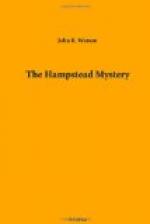The case for the defence depended to a great extent on the plan of Riversbrook which Hill candidly admitted he had drawn. His learned friend had called evidence to show that the paper on which the plan was drawn was of a quality which was not procurable by the general public. That might be so, but what his learned friend had not succeeded in doing, and could not possibly have hoped to succeed in doing, was to show that Birchill could not have obtained possession in any other way of paper of that kind. Yet it was necessary for the defence to prove that, in order to prove that the plan was not drawn at Fanning’s flat by Hill under threats from Birchill, but that Hill had drawn it at Riversbrook, and that he gave it to Birchill in order to induce him to consent to the proposal to break into the house. There were dozens of ways in which paper of this particular quality might have got to the flat. Might not Birchill have a friend in His Majesty’s Stationery Office? Was it impossible that the witness Fanning had a friend in that Office, or in one of the Government Departments to which the paper was supplied? Was it impossible in view of her relations with the victim of this crime for Fanning to have obtained some of the paper at Riversbrook and to have taken it home to her flat? She had sworn in the witness-box that she had not had paper of that kind in her possession, but with her lover’s life at stake was she likely to stick at a lie if it would help to get him off?
Counsel for the defence had endeavoured to make much of the fact that the dead body of Sir Horace Fewbanks was fully dressed when the police discovered it. He endeavoured to persuade them that such a fact established the complete innocence of the prisoner and that because of it they must bring in a verdict of “not guilty.” He asked them to accept it as evidence not only that Sir Horace Fewbanks was dead when the prisoner broke into the house, but that he was dead when Hill left Riversbrook at 7.30 p. m. to meet Birchill at Fanning’s flat. With an ingenuity which did credit to his imagination, he put before them as his theory of the crime that a quarrel took place between Sir Horace Fewbanks and Hill at Riversbrook, that Hill shot his master and then went to Fanning’s flat so as to see that Birchill carried out the burglary as arranged, and at the same time found Sir Horace’s dead body, and thus directed suspicion to himself. The only support for this, far-fetched theory was that the body when discovered by the police was fully dressed,




